Abstract
The chemoattraction of Propionibacterium acnes lipase for neutrophils and the effect of lipase inhibitor and two antibiotic agents on the chemotaxis were evaluated. Of the various fractions tested, partially purified lipase (fraction 2c) was the most active cytotaxin produced by P. acnes. Serum mediators were not required for the generation of chemotaxis by lipase in vitro. Diisopropyl phosphofluoridate at low concentration (10(-4) mM) completely inhibited lipase activity as well as polymorphonuclear leukocyte chemotaxis generated by lipase. Tetracycline hydrochloride and erythromycin base at concentrations of 10(-1) mM and 1 mM, respectively, caused 100% inhibition of PMN migration toward lipase or zymosan-activated serum. The inhibiting activity of the antibiotics was directed against cells independently of any effect on lipase. Chemotaxis by P. acnes lipase suggests a wider role for this enzyme in the inflammatory process and the pathogenesis of acne vulgaris.
Full text
PDF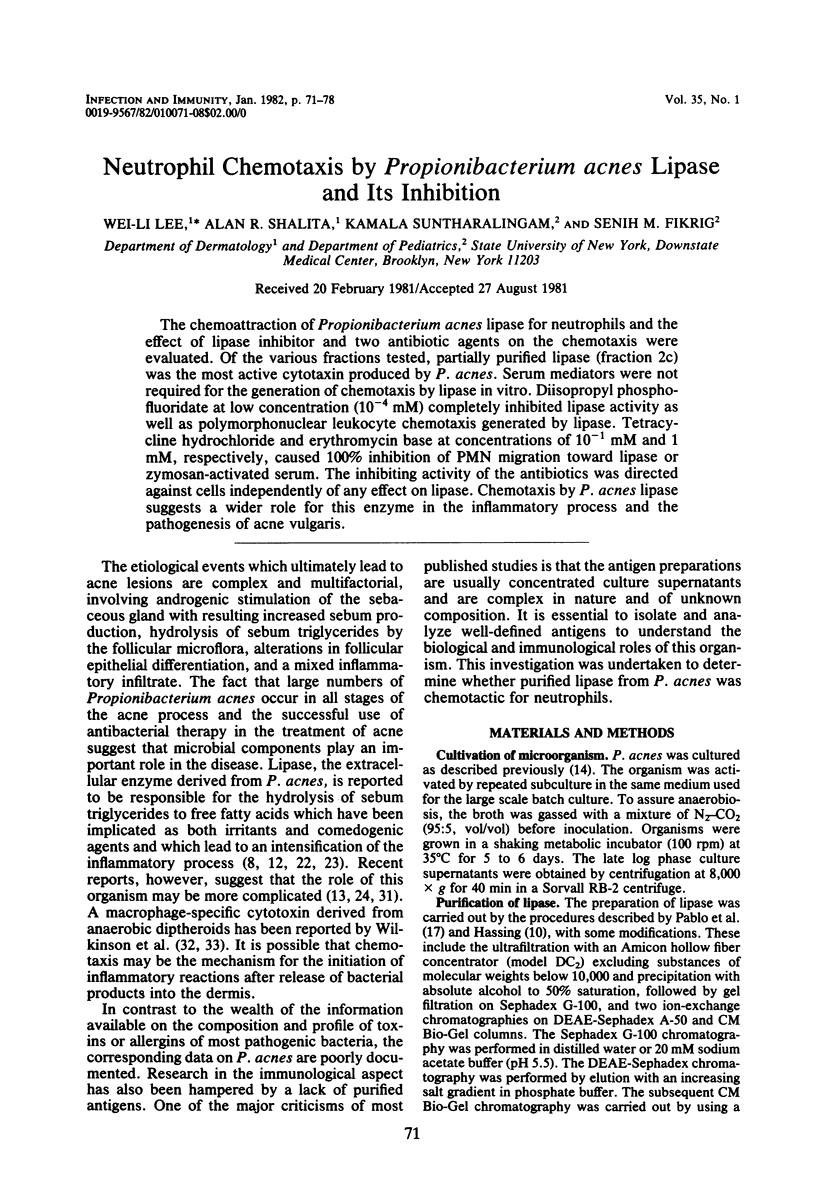
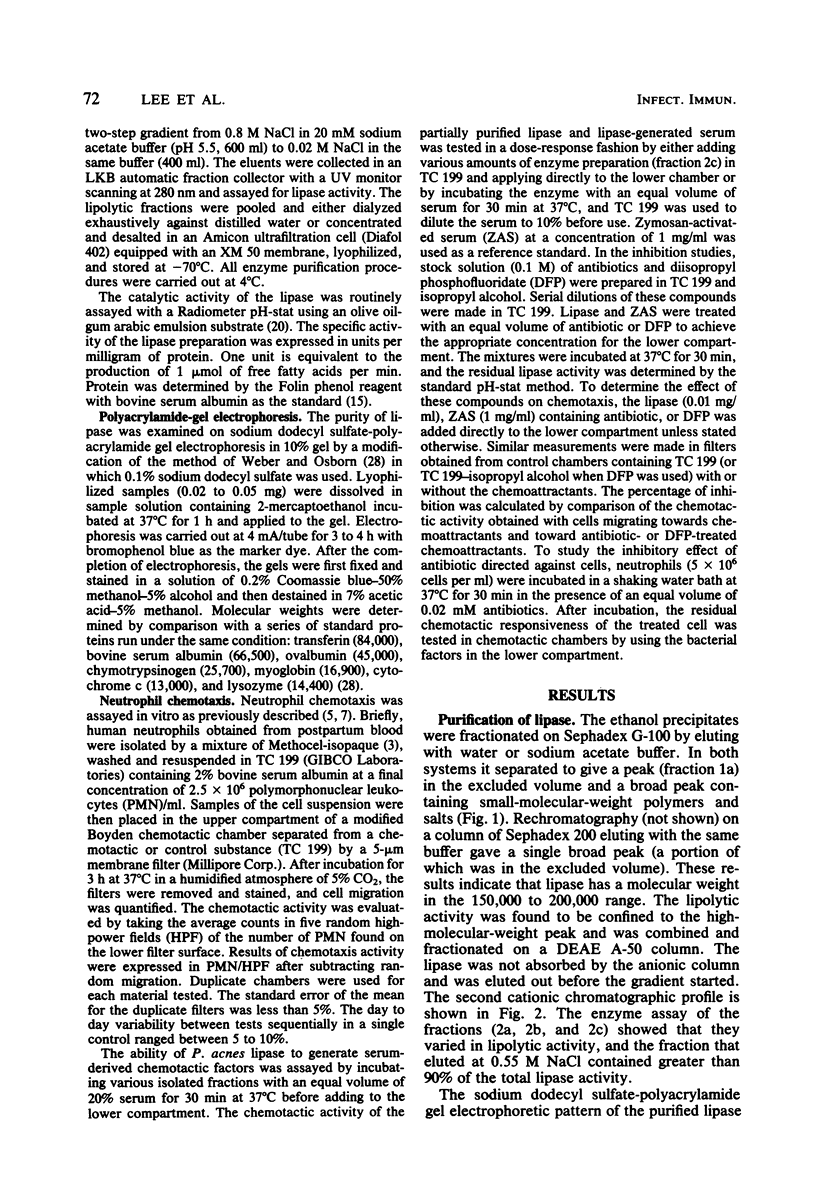
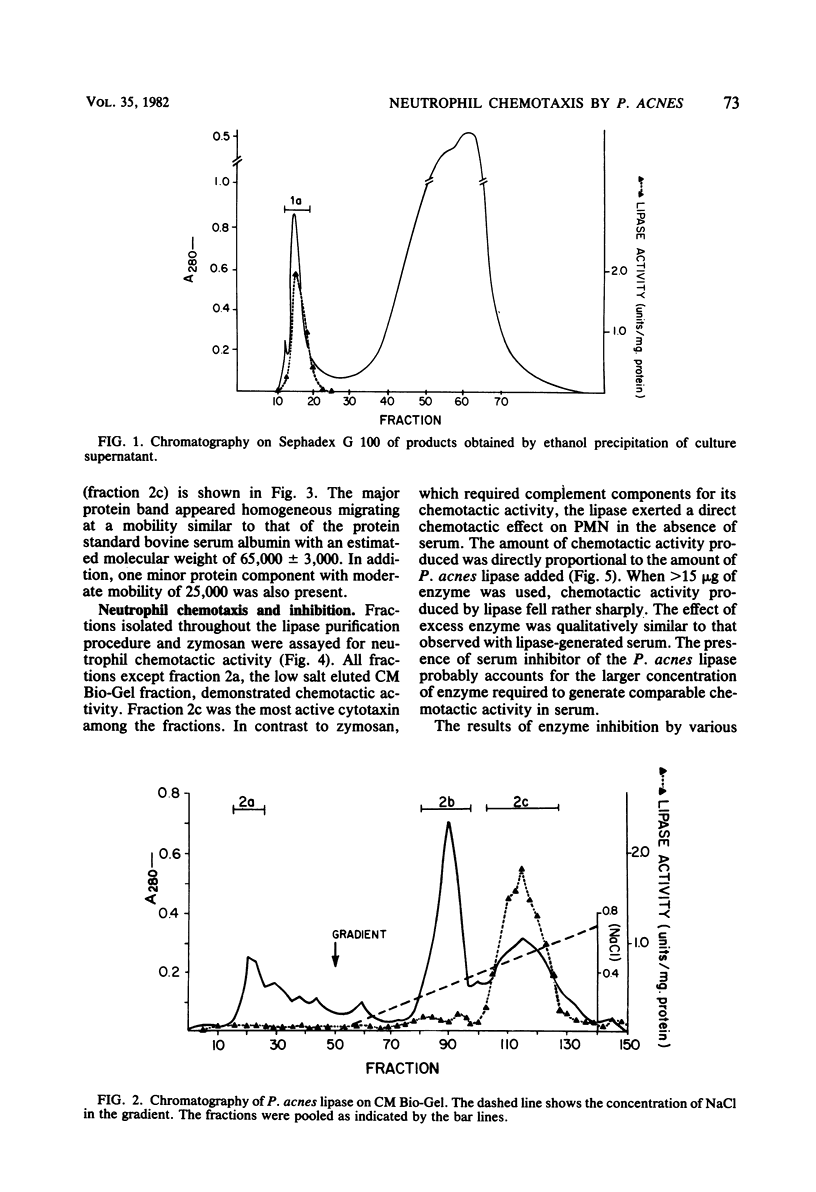
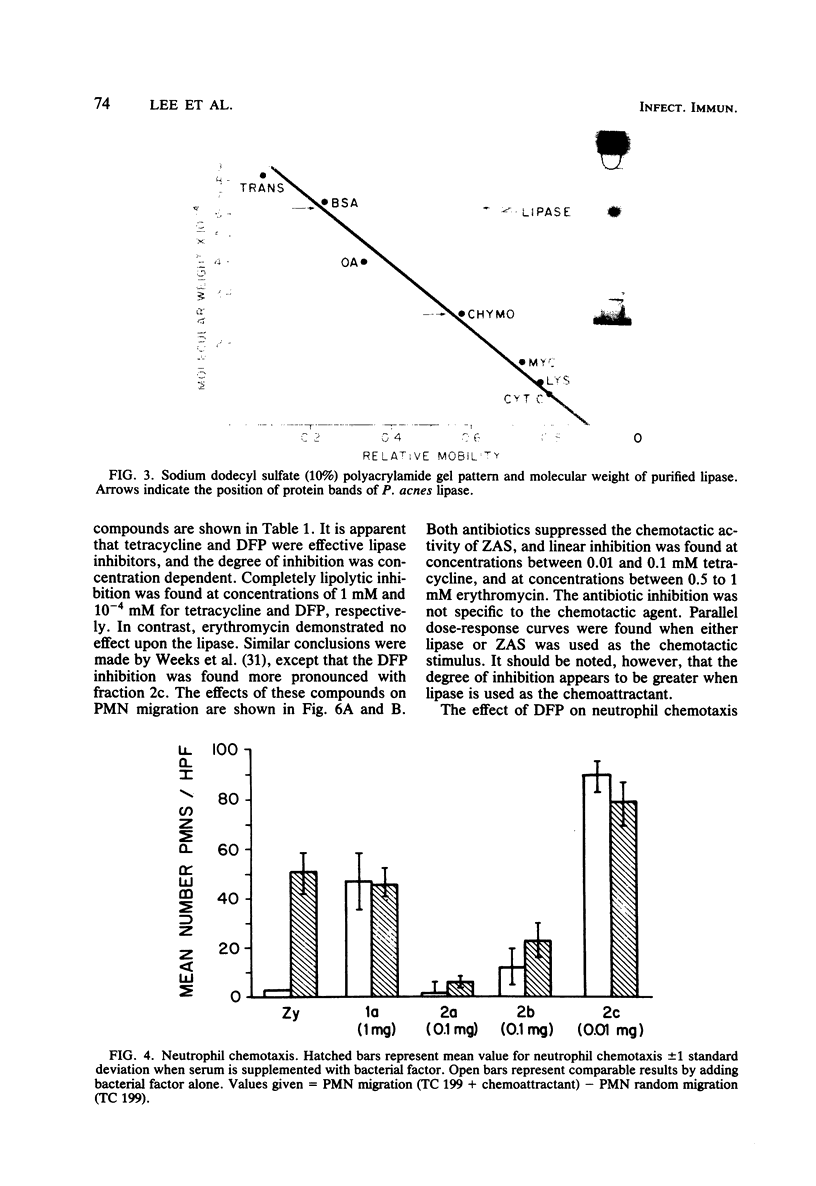
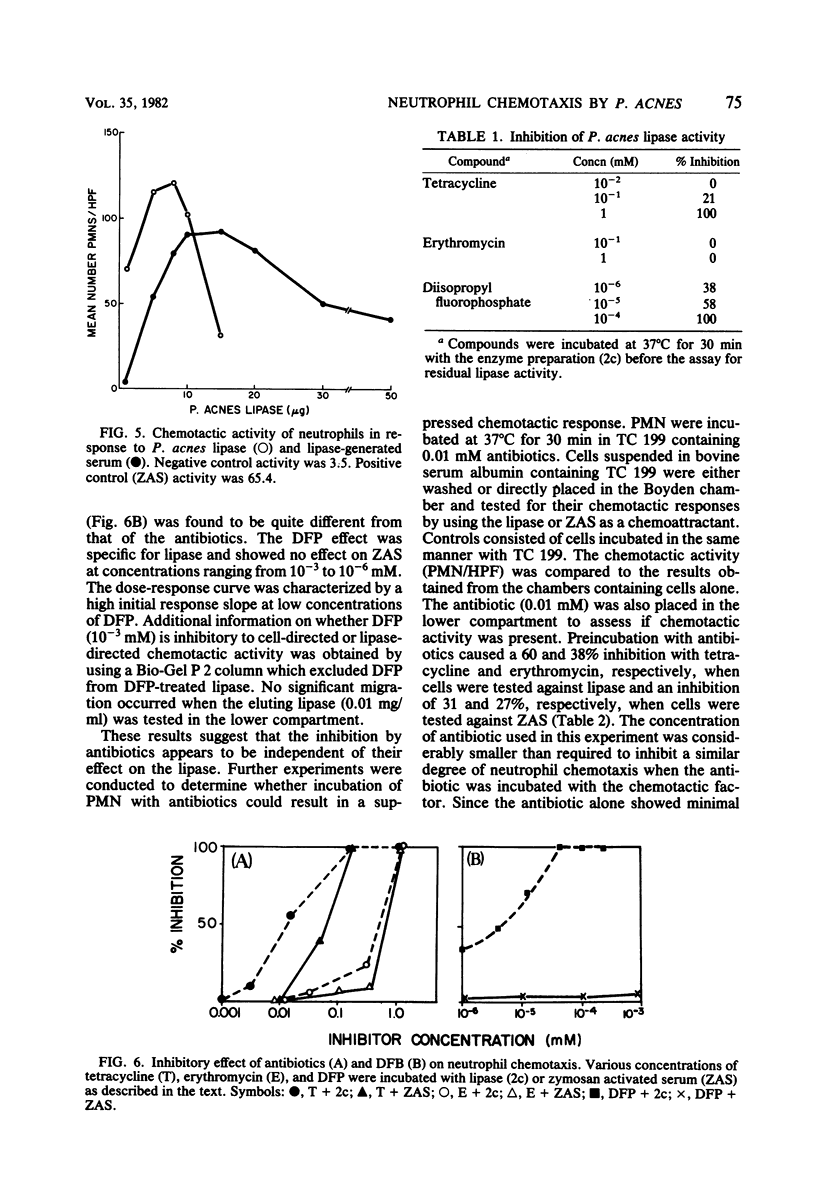
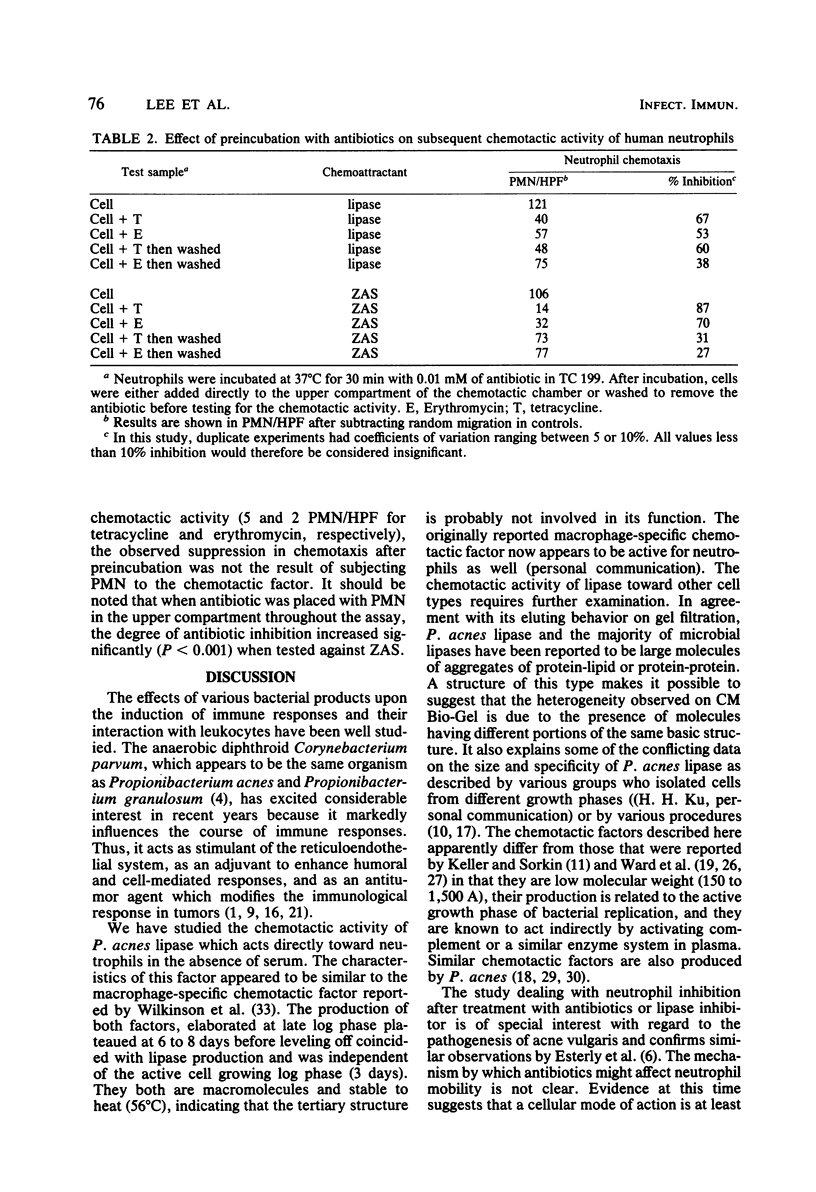

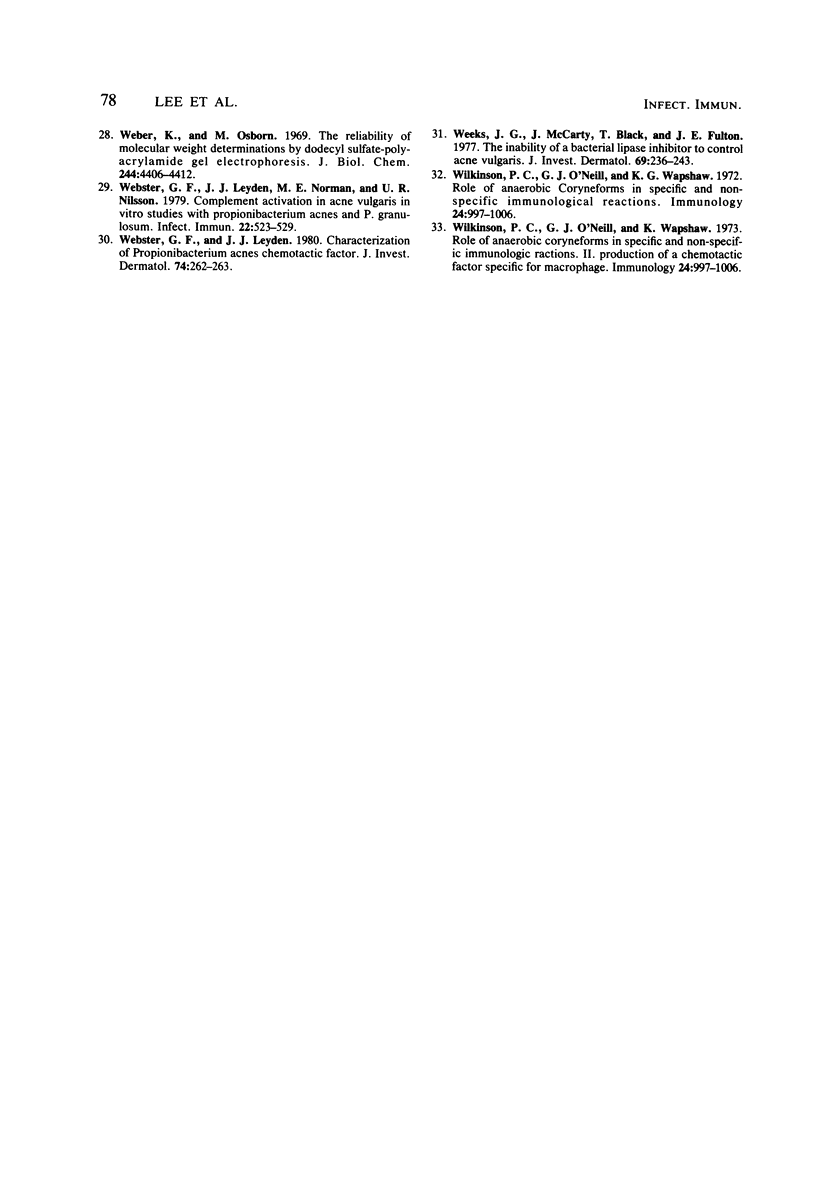
Images in this article
Selected References
These references are in PubMed. This may not be the complete list of references from this article.
- Adlam C., Scott M. T. Lympho-reticular stimulatory properties of Corynebacterium parvum and related bacteria. J Med Microbiol. 1973 Aug;6(3):261–274. doi: 10.1099/00222615-6-3-261. [DOI] [PubMed] [Google Scholar]
- BOYUM A. SEPARATION OF WHITE BLOOD CELLS. Nature. 1964 Nov 21;204:793–794. doi: 10.1038/204793a0. [DOI] [PubMed] [Google Scholar]
- Cummins C. S., Johnson J. L. Corynebacterium parvum: a synonym for Propionibacterium acnes? J Gen Microbiol. 1974 Feb;80(2):433–442. doi: 10.1099/00221287-80-2-433. [DOI] [PubMed] [Google Scholar]
- Edelson P. J., Stites D. P., Gold S., Fudenberg H. H. Disorders of neutrophil function. Defects in the early stages of the phagocytic process. Clin Exp Immunol. 1973 Jan;13(1):21–28. [PMC free article] [PubMed] [Google Scholar]
- Esterly N. B., Furey N. L., Flanagan L. E. The effect of antimicrobial agents on leukocyte chemotaxis. J Invest Dermatol. 1978 Jan;70(1):51–55. doi: 10.1111/1523-1747.ep12543487. [DOI] [PubMed] [Google Scholar]
- Fikrig S. M., Karl S. C., Suntharalingam K. Neutrophil chemotaxis in patients with burns. Ann Surg. 1977 Dec;186(6):746–748. doi: 10.1097/00000658-197712000-00015. [DOI] [PMC free article] [PubMed] [Google Scholar]
- Freinkel R. K. Pathogenesis of acne vulgaris. N Engl J Med. 1969 May 22;280(21):1161–1163. doi: 10.1056/NEJM196905222802106. [DOI] [PubMed] [Google Scholar]
- Halpern B. N., Biozzi G., Stiffel C., Mouton D. Inhibition of tumour growth by administration of killed corynebacterium parvum. Nature. 1966 Nov 19;212(5064):853–854. doi: 10.1038/212853a0. [DOI] [PubMed] [Google Scholar]
- KIRSCHBAUM J. O., KLIGMAN A. M. THE PATHOGENIC ROLE OF CORYNEBACTERIUM ACNES IN ACNE VULGARIS. Arch Dermatol. 1963 Dec;88:832–833. doi: 10.1001/archderm.1963.01590240156026. [DOI] [PubMed] [Google Scholar]
- Kligman A. M. An overview of acne. J Invest Dermatol. 1974 Mar;62(3):268–287. doi: 10.1111/1523-1747.ep12676801. [DOI] [PubMed] [Google Scholar]
- LOWRY O. H., ROSEBROUGH N. J., FARR A. L., RANDALL R. J. Protein measurement with the Folin phenol reagent. J Biol Chem. 1951 Nov;193(1):265–275. [PubMed] [Google Scholar]
- Lee W. L., Shalita A. R., Poh-Fitzpatrick M. B. Comparative studies of porphyrin production in Propionibacterium acnes and Propionibacterium granulosum. J Bacteriol. 1978 Feb;133(2):811–815. doi: 10.1128/jb.133.2.811-815.1978. [DOI] [PMC free article] [PubMed] [Google Scholar]
- O'Neill G. J., Henderson D. C., White R. G. The role of anaerobic coryneforms on specific and non-specific immunological reactions. I. Effect on particle clearance and humoral and cell-mediated immunological responses. Immunology. 1973 Jun;24(6):977–995. [PMC free article] [PubMed] [Google Scholar]
- Pablo G., Hammons A., Bradley S., Fulton J. E., Jr Characteristics of the extracellular lipases from Corynebacterium acnes and Staphylococcus epidermidis. J Invest Dermatol. 1974 Aug;63(2):231–238. doi: 10.1111/1523-1747.ep12679494. [DOI] [PubMed] [Google Scholar]
- Puhvel S. M., Sakamoto M. Cytotaxin production by comedonal bacteria (Propionibacterium acnes, Propionibacterium granulosum and Staphylococcus epidermidis). J Invest Dermatol. 1980 Jan;74(1):36–39. doi: 10.1111/1523-1747.ep12514592. [DOI] [PubMed] [Google Scholar]
- Schiffmann E., Showell H. V., Corcoran B. A., Ward P. A., Smith E., Becker E. L. The isolation and partial characterization of neutrophil chemotactic factors from Escherichia coli. J Immunol. 1975 Jun;114(6):1831–1837. [PubMed] [Google Scholar]
- Shalita A. R., Wheatley V. Inhibition of pancreatic lipase by tetracyclines. J Invest Dermatol. 1970 May;54(5):413–415. doi: 10.1111/1523-1747.ep12259225. [DOI] [PubMed] [Google Scholar]
- Smith L. H., Woodruff M. F. Comparative effect of two strains of C. parvum on phagocytic activity and tumour growth. Nature. 1968 Jul 13;219(5150):197–198. doi: 10.1038/219197a0. [DOI] [PubMed] [Google Scholar]
- Strauss J. S., Pochi P. E. Intracutaneous injection of sebum and comedones. Histological observations. Arch Dermatol. 1965 Oct;92(4):443–456. [PubMed] [Google Scholar]
- Tucker S. B., Rogers R. S., 3rd, Winkelmann R. K., Privett O. S., Jordon R. E. Inflammation in acne vulgaris: leukocyte attraction and cytotoxicity by comedonal material. J Invest Dermatol. 1980 Jan;74(1):21–25. doi: 10.1111/1523-1747.ep12514573. [DOI] [PubMed] [Google Scholar]
- Voss J. G. Acne vulgaris and free fatty acids. A review and criticism. Arch Dermatol. 1974 Jun;109(6):894–898. [PubMed] [Google Scholar]
- Ward P. A., Becker E. L. Mechanisms of the inhibition of chemotaxis by phosphonate esters. J Exp Med. 1967 Jun 1;125(6):1001–1020. doi: 10.1084/jem.125.6.1001. [DOI] [PMC free article] [PubMed] [Google Scholar]
- Ward P. A., Cochrane C. G., Muller-Eberhard H. J. Further studies on the chemotactic factor of complement and its formation in vivo. Immunology. 1966 Aug;11(2):141–153. [PMC free article] [PubMed] [Google Scholar]
- Ward P. A., Lepow I. H., Newman L. J. Bacterial factors chemotactic for polymorphonuclear leukocytes. Am J Pathol. 1968 Apr;52(4):725–736. [PMC free article] [PubMed] [Google Scholar]
- Weber K., Osborn M. The reliability of molecular weight determinations by dodecyl sulfate-polyacrylamide gel electrophoresis. J Biol Chem. 1969 Aug 25;244(16):4406–4412. [PubMed] [Google Scholar]
- Webster G. F., Leyden J. J., Norman M. E., Nilsson U. R. Complement activation in acne vulgaris: in vitro studies with Propionibacterium acnes and Propionibacterium granulosum. Infect Immun. 1978 Nov;22(2):523–529. doi: 10.1128/iai.22.2.523-529.1978. [DOI] [PMC free article] [PubMed] [Google Scholar]
- Weeks J. G., McCarty L., Black T., Fulton J. E., Jr The inability of a bacterial lipase inhibitor to control acne vulgaris. J Invest Dermatol. 1977 Aug;69(2):236–243. doi: 10.1111/1523-1747.ep12506360. [DOI] [PubMed] [Google Scholar]
- Wilkinson P. C., O'Neill G. J., Wapshaw K. G. Role of anaerobic coryneforms in specific and non-specific immunological reactions. II. Production of a chemotactic factor specific for macrophages. Immunology. 1973 Jun;24(6):997–1006. [PMC free article] [PubMed] [Google Scholar]



